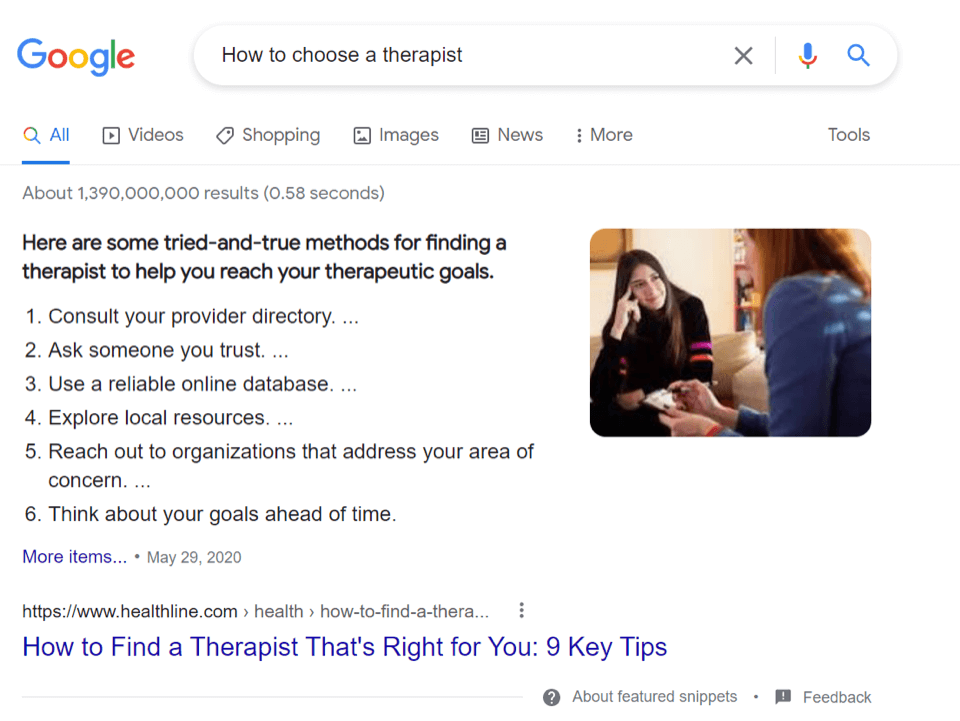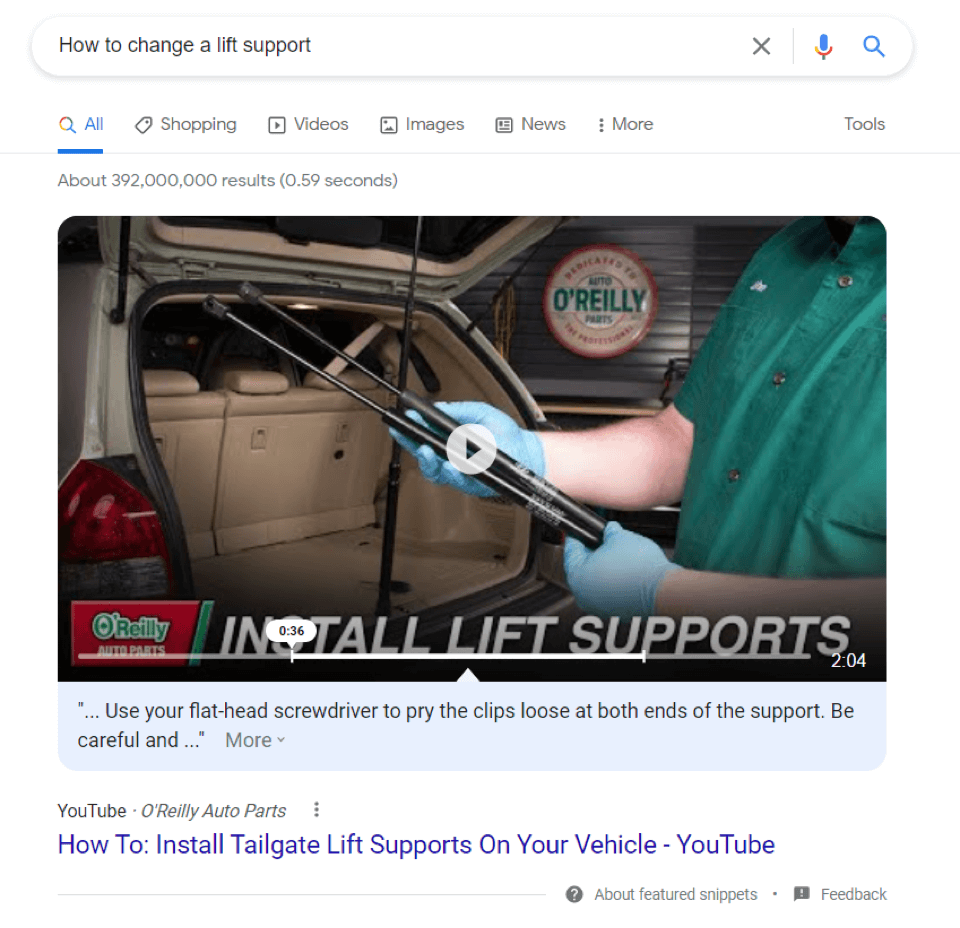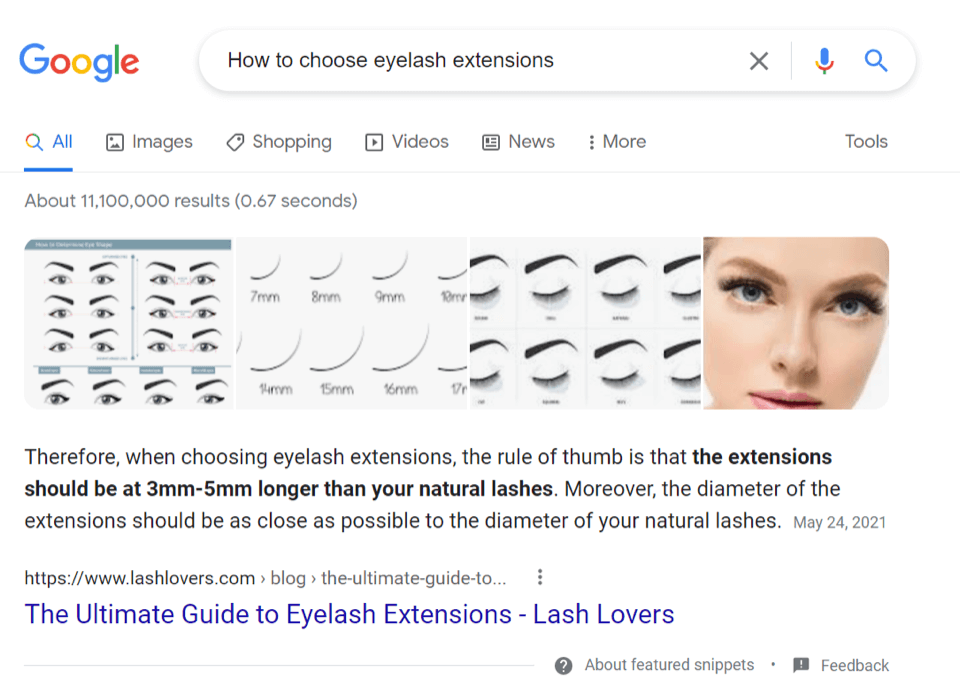SEO plays a major role in digital marketing strategy, and there are many different aspects of SEO that can be leveraged to achieve better results. One lesser-known factor is featured snippets. These little nuggets of wisdom at the top of Google SERPs are not only valuable to Google users but also to businesses. But what exactly are they, and what do business owners need to know to learn how to optimize for featured snippets? We discuss everything business owners need to know about Google featured snippets and what types of featured snippets they can optimize for!
What Are Featured Snippets?
Featured snippets are small boxes of information located above the first search result on SERPs that are designed to address a user’s query. For example, if users search for “how to braid hair,” the first result that will pop up will be a featured snippet with a video demonstrating how to braid hair (although there are different types of featured snippets that may appear in response to a query, which we will cover further in this guide). Why does Google have this feature? This handy search feature makes it easier for users to get their answers more quickly without having to sift through a host of search results.
Why Should a Business Focus on Featured Snippets?
Featured snippets can be an excellent way for businesses to boost their exposure on SERPs. 99% of all featured snippets appear within the first organic position, and for mobile users, these snippets take up 50% of the screen, encouraging higher CTR. Put simply, the different types of featured snippets not only help Google users find the answers they need, but they also help drive traffic to websites. Targeting featured snippets can help business websites rank at the top of organic search results.
What Are the Different Types of Featured Snippets?

There are many different types of featured snippets that a business can target to boost traffic and position themselves as authorities in their niche. Before we discuss how to optimize for featured snippets, let’s take a look at the various snippets that are available on Google SERPs.
- Paragraphs: These small answer boxes help users answer questions that they’re looking for in their search query. Approximately 70% of featured snippets are paragraphs, making these snippets a major focus for anyone looking to leverage the benefits of featured snippets for themselves. These answer boxes give users a quick response to their questions, encouraging them to click on the website to learn more about the topic that they’re researching. This is a great incentive for businesses to set up blogs on their websites!
- Lists: Lists are an excellent way for users to see ranked and unranked lists of items pertaining to their search queries. These will often come from lists found within content, whether that’s a “Best Of” article, a listicle, or even a section breaking down the features or aspects of the blog topic within a given blog. Lists are a bit more extensive than their paragraph counterparts and take up more of the page, which commands more attention from users. This can be another type of content for businesses to prioritize when targeting the many different types of featured snippets. Keep in mind, however, that there are numbered lists and bulleted lists, so business owners will need to vary their content to effectively target both!
- Tables: Tables are featured snippets that often compare pieces of information or help users gain more insight into their topic of research via a visual medium. Let’s imagine that a business owner is looking into the earnings of companies in their field. Plugging in a search query might produce a table that features the name of the companies, their total revenue from last year, and the market cap.
- Videos: Videos are special types of featured snippets that generally populate as a result of “how-to” search queries. This can be a great way to drive exposure to video content as well as written content.
In addition to all of the types of snippets above, there are a few more that are less common. These snippets include the carousel snippet, in which Google will provide users with multiple suggested keywords above or below the snippet to help them get a more specific answer to their question (for example, looking up insurance may prompt Google to suggest more specific keywords to help users get a better answer), double-featured snippets, where Google will display two snippets instead of just one to comprehensively answer a user query (this is good news for authoritative websites with stellar content), and two-for-one snippets, or snippets that feature two different websites and content, often a piece of content from a website paired with a video.
While a particular business may not necessarily hit all of these different types of featured snippets as they create content, knowing about them can help business owners (or the SEO companies that oversee their digital marketing) curate content that may help them get paragraphs, videos, or lists onto SERPs. As they develop their blogs or other marketing channels, business owners may wish to try to create content for all of these snippets to improve their chances of getting exposure and increasing traffic for important keywords.
How To Optimize Content for Featured Snippets

While featured snippets only appear for 11% out of 5.5 million SERPs, writing with the intent of getting content featured above the first organic search result can be a great way to drive traffic to business websites and beat out other websites ranking higher on SERPs. Here are a few tips on how to optimize content for featured snippets to improve the chances of being featured on SERPs.
Take a Look at Keywords that Already Trigger Featured Snippets
One of the best ways to improve the chances of having content dominate the many types of featured snippets on the web is to find where Google is already employing them. Let’s imagine that a business owner runs an agricultural supplies business and there’s a keyword for “x best farm equipment” that triggers a featured snippet. One important strategy as they learn how to optimize for featured snippets is to optimize a piece of content for a keyword that already has a featured snippet attached to it so that they might bump a competitor out of this spot and get their content to users searching for this exact query.
While it’s possible to see a featured snippet with a business website’s content appear on SERPs that didn’t previously have a snippet, it’s more effective to target queries that already display snippets.
Be Informative and Concise
No matter which types of featured snippets a business owner might be targeting, it’s important to remember to optimize for Google. As such, creating long walls of text or poorly written, unfocused content isn’t going to get the best results. Satisfy both Google and readers by writing concisely and offering informative, actionable, and insightful content. This approach provides answers to the questions that users may be searching for in only a few sentences or a paragraph. This may not always apply to certain types of featured snippets like videos or tables, but it’s a good general rule to follow when producing content regardless.
Format Content Properly
Learning how to optimize for featured snippets often means learning and applying SEO best practices. Another important focus is to format content effectively, with a major focus on headings and subheadings. Using keyword-optimized headings that provide a clear response to questions that users are searching for is a great way to get content recognized by Google and placed at the top of SERPs. This applies to lists as well, which should be formatted with numbers, bullet points, or even H3s. Formatting is essential to many types of featured snippets found on Google SERPs.
Leverage Structured Data
The more information Google has to work with when indexing a website and learning how to display it in SERPs in comparison to competitors, the better it will fare in terms of ranking. However, the same is true for featured snippets.
Structured data is a helpful strategy that can be employed to improve the chances of getting featured snippets on various SERPs. Put simply, structured data is a type of code that allows Google to more easily understand what a web page is about. For example, let’s imagine that a business owner runs a cooking website and someone looks up a specific recipe of theirs that shows up at the top of their query. While some recipes may only have the name and an image, those with structured data include the amount of time it takes to cook, some of the ingredients, and relevant calorie information.

Source: Google Search Central
When Google can better understand the context of a business website’s content, it’s more likely to feature it in the different types of featured snippets. Business owners shouldn’t ignore structured data if they want to target these snippets.
Optimize for the Types of Featured Snippets That Are Most Effective to Target
Finally, one of the most helpful tips to learn how to optimize for featured snippets is making sure to optimize for the snippets that are most relevant to a particular website. So far, we’ve discussed a lot of the tips to target list snippets or paragraph snippets. However, a particular business might excel in a particular type of content, such as creating helpful videos. Optimizing for these types of featured snippets means taking the time to optimize the video’s title, add an in-depth description, and create videos centered around search queries where video snippets already exist.
If it’s important for a particular website to be featured in a list, it’s helpful to add lists to content or create listicles. To be featured in a paragraph snippet, dedicate a paragraph to answering the question for the search query and building informative content around that. No matter which types of featured snippets a business owner wishes to target, they should make sure that they’re doing everything in their power to help Google choose their page to be featured at the top of SERPs!
Featured Snippets Are Often Overlooked, but They Can Be a Great Way To Drive Traffic
As a business owner, it isn’t always easy to stay on top of all the important digital marketing best practices. Fortunately, expanding their knowledge base with guides like these allows business owners to employ new strategies that will help them drive traffic to their website using the different types of featured snippets when they’re not at the top of SERPs for a specific keyword.
When creating content targeting a specific keyword and seeking to boost results, use this resource to determine which featured snippets to target and how to properly optimize for them (or enlist the help of an agency well-versed in these practices). Follow the BESTSEO blog for more information about the latest SEO best practices.

